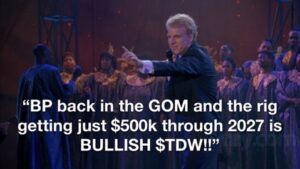Offshore Earnings
A low frequency but juicy strategy where the edge is government incompetence.
Let’s dig in…
We haven’t been exactly bullish in recent months. We aren’t doom and gloomers either, but regime changes tend to create markets where macro Trumps the micro. Are the past 10 days, just a precursor to the coming wackiness and onslaught of “100-year, one-in-a-lifetime moves” that will likely come weekly?? We are in the 4-6 month election blackout period before Project Zim comes back in full force. That said, we are still optimists here, and there’s always a bull theme somewhere in the world…
So, turning to our beloved offshore theme, we figured it was time for an update from our analyst as drillers released earnings on the eve of the market Klusterfuk. They weren’t immune to the macro but collectively, the drillers had a great Q2. Let’s dive in…
Overall, results were driven by high uptime and efficiency, showing a glimpse of the potential they have as we begin rolling legacy contracts onto higher rates. The transition onto higher rate contracts is messy though and is a balancing act of locking in multi-year contracts at high rates while eating up white space for your rigs until those contracts start. These shorter-term contracts can end up being oddly shaped puzzle pieces that have to fit into the space between the driller’s schedule, an E&P’s project list and an E&P’s budget.
One factor cluttering this transition is that as E&P’s are starting to understand the tightness of the rig market over the next few years, they’re batching together a lot of short-term drilling work into longer, consolidated projects. This has helped drive the dayrate and term length of contracts awarded this year, even if the cadence of contract awards is slower than the past 2 years. These contracts have locked up rigs for multiple years, forcing E&P’s to pay up if they wanted to secure the scarce white space for their short-term work (we saw it with Diamond’s $513k 30-day contract and with Seadrill’s $550k 40-day contract, both for 2H24). But the result of the higher-value, longer-term contracts means that rig schedules, E&P project schedules and E&P budgets all become less flexible when drillers are trying to find short-term work to fill white space. If an E&P is in the market for a multi-year contract, they may be less inclined or aggressive to get 1 or 2 wells drilled in the meantime – they’ll either fold it into their upcoming program or decide to focus on this larger, more valuable project they’re pursuing. Valaris and Noble spoke on this during their calls: VAL said it was in discussions with customers for short-term work starting in 3Q24, but the potential projects had either timing or scope changes; NE said that the capital, planning and complexity of long-term contracts have distracted E&P’s from smaller projects fit for 6G/lower-spec rigs.
Despite the short-term snags for 2H24, the drillers, contracts and dayrates are showing the strong progression of the industry during 1H24. When we entered the year, drillers were still trying to solidify pricing levels between $400-450k per day. During 2Q24, long-term contracts are consistently pricing above $475k with multiple contracts announced above $500k.
Thanks to the strong contracting over the past year, most drillers already have a large majority of their active fleet available days spoken for in FY25. Transocean, RIG, has ~90% of its active available days in FY25 already booked. VAL has ~70% of its active floater available days in FY25 booked and a significant roll-off of legacy contracts. Its current backlog has its average floater dayrate increasing from $330k in FY24 to ~$380k in FY25.
The offshore trend continues to grind forward. The transition during the upcycle is messy and depends on the drillers to effectively and efficiently manage their fleets in order to capture the growth in offshore spend and rig demand.
Start your 28-day free trial
Kuppy’s Event Driven Monitor (“KEDM”) is not a financial or investment advisor and the information contained in this publication is not intended to constitute legal, accounting, or text advice or individually-tailored investment advice and is not designed to meet your personal financial situation. The investments discussed in this publication may not be suitable for you. You are required to conduct your own due diligence, analyses, draw your own conclusions, and make your own investment decisions. Any areas concerning legal, accounting, or tax advice or individually-tailored investment advice should be referred to your lawyers, accountants, tax advisors, investment advisers, or other professionals registered or otherwise authorized to provide such advice. KEDM makes no recommendations whatsoever regarding buying, selling, or holding a specified security, a class of securities, or the securities of a class of issuers, and all commentary is for educational purposes only. The investment examples noted are intended to provide and example of the events and data KEDM flags each week and is not representative of typical returns generated by each event or any future returns.


